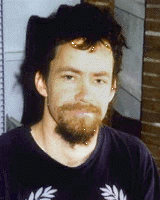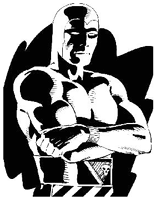
Friends of the Phantom
with Luke McDonnell
DC Phantom Artist

|
An Interview Excerpt
from Friends of the Phantom with Luke McDonnell DC Phantom Artist |
Luke had always been friendly with a quiet demeanor, perhaps preferring to allow his work to speak for him, but when we examined the DC Phantom comics together, his conversation revealed him to be articulate, thoughtful, and intelligent.
FOTP: You had a stylistic departure from the traditional Phantom, an economy of line... almost impressionistic. Did you follow the earlier work? Did anyone influence you?
McDonnell: I wasn't that familiar with the earlier stuff...mostly Sy Barry, but I had the Nostalgia Press Reprints.
FOTP: the Nostalgia Press did Ray Moore.
McDonnell: Yes, I liked his very minimalist simple look. It was really nice.
FOTP: Had you been a Phantom fan long?
McDonnell: Oh yeah. I had scrapbooks where I cut out my favorite comics. pasted them up, like Alley Oop and BC, Peanuts, and I had a whole book full of Phantom strips. My brother and I were both really into him.
FOTP: You have a sterner more action oriented Phantom.
McDonnell: I think I basically wanted to accentuate that kind of Batman quality ....striking fear into the hearts of evil doers. I just thought that would play better to comic book fans than the sort of genial friendly looking Phantom...because comic book fans like that intensity... shadowy menace sort of thing.
FOTP: Whose idea was it to do the origin story in every issue?
McDonnell: I think it was an editorial decision. They said the comic book fans are not as familiar with it...they don't read the strip in the newspaper so it would help if we had this thing and it would be interesting for you to interpret it differently in each issue. It was fun coming up with a different look for each intro. I think it worked out pretty well; it brought people up to speed on it.
FOTP: I noticed you like doing some textural things like scratching over the drawing. How would you describe the technique you used?
McDonnell: Basically, I think whatever the situation called for, whenever I got to the skull cave, I really wanted to give it a lot of texture and pizazz. I ended up using ...in further issues...crayons and paint, razor blades and scratched all over it...anything to get that rough hewn sort of look.

FOTP: Are there any sequences you found especially enjoyable when you did the series?
McDonnell: The stuff that stands out for me was when I was able to get some quiet moments in there although comics is about action...that's what defines comics. Like this page has always been one of my favorites (page 20 issue 7) it's just him walking into this cave finding a guy lying there and he brings him out. There's nobody swinging anything or touching anybody. With moody scenes you can really go to town with shadow and light and design...unlike action where you gotta pretty much show everything.
FOTP: You didn't use a lot of stock poses...you kept devising new poses.
McDonnell: Yeah, I tried to keep him away from stereotypical attitudes and looks. Because he's not that sort of character...he's got a real humanity to him.
FOTP: It must have been some tough time constraints.
McDonnell: Yes, pencilling and inking it. Actually, we never fell that far behind on deadlines on this. The letterer always turned it around fast....Bob Pinaha.
FOTP: Who were some of the artists you admired?
McDonnell: Well, Sy Barry to start with because
he'd been doing the Phantom for so long. He was the guy who put the stamp
on it. Joe Kubert, of course, for the work he did on Tarzan. John Buscema
and all the great classical guys like Hal Foster, who did Prince Valiant.
I didn't do it with the Phantom but there was another series I did called
"Outlaws" where I took a Foster drawing and turned it into a cover... Alex
Raymond, Milton Caniff for his use of lights and darks and plus just looking
at the guys who were doing work at the time like Frank Miller for their
layouts and compositions.